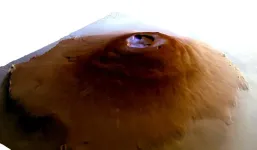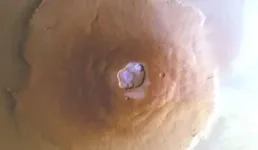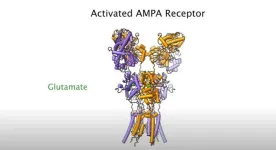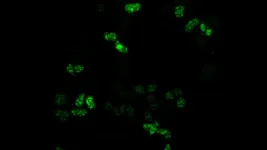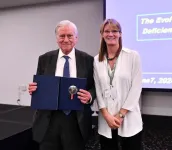(Press-News.org) PROVIDENCE, R.I. [Brown University] — An international team of planetary scientists has detected patches of water frost sitting atop the Tharsis volcanoes on Mars, which are not only the tallest volcanic mountains on the Red Planet but in the entire solar system.
The discovery marks the first time frost has been spotted near the planet’s equator, challenging existing perceptions of the planet’s climate dynamics, according to the team’s new study in Nature Geoscience.
“We thought it was improbable for frost to form around Mars’ equator, as the mix of sunshine and thin atmosphere keeps temperatures during the day relatively high at both the surface and mountaintop — unlike what we see on Earth, where you might expect to see frosty peaks,” said Adomas Valantinas, a postdoctoral fellow at Brown University who led the work as a Ph.D. student at the University of Bern. “What we're seeing may be a remnant of an ancient climate cycle on modern Mars, where you had precipitation and maybe even snowfall on these volcanoes in the past.”
According to the study, the frost is present for only a few hours after sunrise before it evaporates in sunlight. The frost is also incredibly thin — likely only one-hundredth of a millimeter thick or about the width of a human hair. Still, it’s quite vast. The researchers calculate the frost constitutes at least 150,000 tons of water that swaps between the surface and atmosphere each day during the cold seasons. That’s the equivalent of roughly 60 Olympic-size swimming pools.
Tharsis, the region of Mars where the frost was found, hosts numerous volcanoes. They tower above the surrounding plains at heights ranging from one to two times that of Earth’s Mount Everest. Olympus Mons, for instance, is as wide as France.
The frost sits in the calderas of the volcanoes, which are large hollows at their summits created during past eruptions. The researchers propose that the way the air circulates above these mountains creates a unique microclimate that allows the thin patches of frost to form.
The researchers believe modelling how the frosts form could allow scientists to reveal more of Mars’ remaining secrets, including understanding where water exists and how it moves, as well as understanding the planet’s complex atmospheric dynamics, which is essential for future exploration and the search for possible signs of life.
The researchers detected the frost using high-resolution color images from the Colour and Stereo Surface Imaging System (CaSSIS) onboard the European Space Agency’s Trace Gas Orbiter. The findings were then validated using independent observations from the High Resolution Stereo Camera onboard the ESA’s Mars Express orbiter and by the Nadir and Occultation for Mars Discovery spectrometer onboard the Trace Gas Orbiter.
The effort involved analyzing over 30,000 images to both initially find the frost and then confirm its existence. Valantinas filtered the images based on where they were acquired as well as when they were acquired, like the time of day and the season. The meticulous approach helped isolate spectral signatures indicative of water frost and where it formed on the Martian surface.
Valantinas started analyzing the images in 2018. The majority of work was completed while earning his Ph.D. abroad but a portion of the reanalysis was completed while at Brown.
Transitioning to his role at Brown, Valantinas now plans to continue his exploration of Martian mysteries while pivoting to astrobiology. Working in the lab of Brown planetary scientist Jack Mustard, he’ll work toward characterizing ancient hydrothermal environments that could have supported microbial life. Samples from these environments may one day be brought back to Earth by the NASA-lead Mars Sample Return mission.
“This notion of a second genesis, of life beyond Earth, has always fascinated me,” Valantinas said.
END
In a significant first, researchers detect water frost on solar system’s tallest volcanoes
A research team unveiled that Mars’ Tharsis volcanoes have on and off patches of water frost, challenging previous assumptions about the Martian climate and helping shed light on how water behaves on the planet.
2024-06-10
ELSE PRESS RELEASES FROM THIS DATE:
Super-chilled brain cell molecules reveal how epilepsy drug works
2024-06-10
FOR IMMEDIATE RELEASE
By super cooling a molecule on the surface of brain cells down to about minus 180 degrees Celsius — nearly twice as cold as the coldest places in Antarctica — scientists at Johns Hopkins Medicine say they have determined how a widely-used epilepsy drug works to dampen the excitability of brain cells and help to control, although not cure, seizures.
The research, published June 4 in Nature Structural & Molecular Biology, identifies critical connections between activity of the epilepsy drug ...
Benefits of failure are overrated
2024-06-10
The platitude that failure leads to success may be both inaccurate and damaging to society, according to research published by the American Psychological Association.
Researchers conducted 11 experiments with more than 1,800 participants across many domains and compared national statistics to the participants’ responses. In one experiment, participants vastly overestimated the percentage of prospective nurses, lawyers and teachers who pass licensing exams after previously failing them.
“People expect success to follow failure much more often than it actually does,” said lead researcher Lauren Eskreis-Winkler, PhD, an assistant ...
NUTRITION 2024 showcases groundbreaking research on what we eat and why it matters
2024-06-10
Don’t miss your chance to be among the first to hear breaking news in food and nutrition science at NUTRITION 2024. The annual flagship meeting of the American Society for Nutrition will be held June 29–July 2 at McCormick Place in Chicago.
Reporters and bloggers are invited to explore the meeting schedule and register for a complimentary press pass to attend.
The meeting will feature stimulating discussions, exciting research announcements and updates from groups shaping the nutrition and health policies that affect us all. Highlights include:
Diet and exercise performance – As the ...
Icahn School of Medicine at Mount Sinai awarded $21 million NIH grant to advance understanding of aging-related hormone
2024-06-10
New York, NY [June 10, 2024]—Researchers at the Icahn School of Medicine at Mount Sinai have been awarded a $21 million grant from the National Institute on Aging (NIA) of the National Institutes of Health (NIH), to further advance understanding of an aging-related hormone known as follicle-stimulating hormone (FSH), including its potential role in obesity, osteoporosis, and Alzheimer’s disease. The work could lead to the development of new treatments for these and other conditions involving aging.
This is a collaborative ...
RNA splicing’s spotters
2024-06-10
Bodybuilders and cellular mechanisms agree generating protein is a heavy lift. To complete the task, cells rely on complexes called spliceosomes. These molecular machines snip extra bits out of our genes’ RNA copies and piece together precise instructions for protein-building. When the splicing process goes awry, it can result in diseases like cancer or spinal muscular atrophy. Cold Spring Harbor Laboratory (CSHL) Professor Adrian Krainer helped develop the first FDA-approved treatment for this devastating genetic disorder. Now, his team has discovered that two important regulator proteins work together ...
Clinical trial shows promising results in a two-drug combination that curbs methamphetamine use
2024-06-10
A clinical trial on a two-drug therapy for methamphetamine use disorder reduced use of the highly addictive drug for up to 12 weeks after initiation of treatment, UCLA-led research suggests.
Participants in the ADAPT-2 clinical trial who received a combination of injectable naltrexone plus extended-release oral bupropion (NTX+BUPN) had a 27% increase in methamphetamine-negative urine tests, indicating reduced usage. By contrast, the placebo group had an 11% increase in negative tests.
The study will be published in the peer-reviewed journal Addiction.
“These ...
Gut microbes from aged mice induce inflammation in young mice, study finds
2024-06-10
CHAMPAIGN, Ill. — When scientists transplanted the gut microbes of aged mice into young “germ-free” mice — raised to have no gut microbes of their own — the recipient mice experienced an increase in inflammation that parallels inflammatory processes associated with aging in humans. Young germ-free mice transplanted with microbes from other young mice had no such increase.
The findings suggest that changes to the gut microbiome play a role in the systemwide inflammation that often occurs ...
Valentin Fuster, MD, Ph.D., received 2024 Distinguished Award from European Society for Clinical Investigation (ESCI)
2024-06-10
The European Society for Clinical Investigation (ESCI) is awarding Valentin Fuster, MD, PhD, President of Mount Sinai Heart and Physician-in-Chief of The Mount Sinai Hospital, its ESCI Distinguished Medal for 2024. He received this honor during the ESCI Annual Scientific Meeting in Barcelona, Spain, during a special ceremony on Friday, June 7.
The ESCI Medal is awarded yearly for outstanding achievements in clinical investigation and for the teaching of young scientists and medical specialists.
This prestigious recognition highlights Dr. Fuster’s significant contributions to the worldwide field of cardiology. Dr. Fuster’s work has been ...
Planetary Health Diet associated with lower risk of premature death, lower environmental impact
2024-06-10
Embargoed for release: Monday, June 10, 7:00 AM ET
Key takeaways:
People whose diets most closely adhered to the Planetary Health Diet (PHD) had 30% lower risk of premature death compared to those with the lowest adherence.
Every major cause of death, including cancer, heart disease, and lung disease, was lower with greater adherence to this dietary pattern.
Diets adhering to the PHD pattern had substantially lower environmental impact, including 29% lower greenhouse gas emissions and 51% less land use.
Boston, MA—People who eat a healthy, sustainable diet may ...
Improved prime editing system makes gene-sized edits in human cells at therapeutic levels
2024-06-10
Scientists at the Broad Institute of MIT and Harvard have improved a gene-editing technology that is now capable of inserting or substituting entire genes in the genome in human cells efficiently enough to be potentially useful for therapeutic applications.
The advance, from the lab of Broad core institute member David Liu, could one day help researchers develop a single gene therapy for diseases such as cystic fibrosis that are caused by one of hundreds or thousands of different mutations in a gene. Using this new approach, they would insert a healthy copy of the gene at its native location in the genome, rather than having to create a different ...
LAST 30 PRESS RELEASES:
Scientists boost cell "powerhouses" to burn more calories
Automatic label checking: The missing step in making reliable medical AI
Low daily alcohol intake linked to 50% heightened mouth cancer risk in India
American Meteorological Society announces Rick Spinrad as 2026 President-Elect
Biomass-based carbon capture spotlighted in newly released global climate webinar recording
Illuminating invisible nano pollutants: advanced bioimaging tracks the full journey of emerging nanoscale contaminants in living systems
How does age affect recovery from spinal cord injury?
Novel AI tool offers prognosis for patients with head and neck cancer
Fathers’ microplastic exposure tied to their children’s metabolic problems
Research validates laboratory model for studying high-grade serous ovarian cancer
SIR 2026 delivers transformative breakthroughs in minimally invasive medicine to improve patient care
Stem Cell Reports most downloaded papers of 2025 highlight the breadth and impact of stem cell research
Oxford-led study estimates NHS spends around 3% of its primary and secondary care budget on the health impacts of heat and cold in England
A researcher’s long quest leads to a smart composite breakthrough
Urban wild bees act as “microbial sensors” of city health.
New study finds where you live affects recovery after a hip fracture
Forecasting the impact of fully automated vehicle adoption on US road traffic injuries
Alcohol-related hospitalizations from 2016 to 2022
Semaglutide and hospitalizations in patients with obesity and established cardiovascular disease
Researchers ‘listen in’ to embryo-mother interactions during implantation using a culture system replicating the womb lining
How changing your diet could help save the world
How to make AI truly scalable and reliable for real-time traffic assignment?
Beyond fragmented markets: A new framework for efficient and stable ride-pooling
Can shape priors make road perception more reliable for autonomous driving?
AI tracks nearly 100 years of aging research, revealing key trends and gaps
Innovative techniques enable Italy’s first imaging of individual trapped atoms
KIER successfully develops Korea-made “calibration thermoelectric module” for measuring thermoelectric device performance
Diversifying US Midwest farming for stability and resilience
Emphasizing immigrants’ deservingness shifts attitudes
Japanese eels, climate change, and river temperature
[Press-News.org] In a significant first, researchers detect water frost on solar system’s tallest volcanoesA research team unveiled that Mars’ Tharsis volcanoes have on and off patches of water frost, challenging previous assumptions about the Martian climate and helping shed light on how water behaves on the planet.
